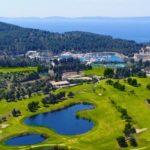Slow Miles in a Small Country: Walking Through Slovenia’s Soul

There’s a softness to Slovenia that you don’t notice from a car. Its beauty isn’t theatrical. It’s not trying to impress you. But when you walk—when your pace matches the rhythm of the place—it reveals itself generously.
Table of Contents
ToggleSlow Miles in a Small Country: Walking Through Slovenia’s Soul
It wasn’t a landmark that first moved me in Slovenia. It was silence—the kind that hangs in the air before the world wakes up. The kind that invites you to lean in and listen.
I’d landed in Slovenia without a plan. A few guidebook pages, a name—Lake Bohinj—and a guesthouse booking were all I carried. But when I stepped out that first morning and saw the mist unraveling across still water and peaks looming with quiet confidence, something shifted. I didn’t want to “see the sights.” I wanted to walk straight into them.
Walking as a Way of Seeing
There’s a softness to Slovenia that you don’t notice from a car. Its beauty isn’t theatrical. It’s not trying to impress you. But when you walk—when your pace matches the rhythm of the place—it reveals itself generously.
A gravel path leads from one village to the next. A signpost points into a cherry orchard. A dog trots beside you for a kilometer before turning back home. You follow forest trails that open to meadows and cross farmyards where no one seems to mind. There’s a permeability here—between nature and people, between visitor and local—that invites you in.
It’s this sense of deep connection that makes Slovenia walking holidays so uniquely rewarding—not just scenic, but soulful in a way that stays with you long after you’ve returned home.
Encounters That Only Happen When You Walk
In the Vipava Valley, I passed a garden where an old woman was tending herbs. She waved. I waved back. A moment later, I was sitting under a fig tree drinking plum brandy and listening to her explain, in slow Slovenian and hand gestures, how her father made wine with his feet.
Another day, in the hills near Tolmin, a group of school children offered me wild strawberries and asked if I liked hiking. “Only tourists drive everywhere,” one of them said with the certainty of a ten-year-old. “Walking is the better way.”
A Landscape in Constant Conversation
Slovenia doesn’t make you choose between wilderness and comfort. You can climb a mountain in the morning and sip wine by late afternoon. The country is compact, but its ecosystems are wildly varied—Julian Alps, Mediterranean coast, rolling vineyards, hidden waterfalls, and high meadows stitched together by centuries-old paths.
I walked part of the Alpe-Adria Trail, where the Soča River flows clear and cold, too blue to seem real. At one bend, I saw a fisherman casting into the mist. At another, a barefoot couple was reading poetry on a rock. The trail felt less like a route and more like a story I was walking my way into.
For anyone seeking landscapes that shift as smoothly as the pace beneath your boots, Slovenia walking holidays offer an ever-changing stage—where every day feels like a new chapter.
When to Come, and What to Leave Behind
Avoid high summer if you can. Go in May or late September. The weather is kind, and the trails feel like yours alone. Even in more popular places—Lake Bled, Ljubljana’s old town—a ten-minute walk can shift you from crowds to calm.
Don’t bring too much. Slovenia rewards lightness—in gear, in schedule, in expectations. Every day offers something small and unexpected: a shrine in the woods, a farmer selling cheese from a kitchen window, a church bell echoing through evening air.
Not Just Travel—A Way of Being
What surprised me most wasn’t the scenery or the food (though both are quietly excellent). It was the feeling that walking here didn’t just take me through Slovenia—it taught me how to be in it.
There’s a groundedness in the way Slovenians move through their world. They know their land, not just as scenery, but as home. They hike because it’s how they spend time together. Trails aren’t tourist features—they’re lifelines connecting lives.
One afternoon, I sat beside a man on a wooden bench overlooking a wide green valley. We didn’t speak the same language, but when he tapped his walking stick against the earth and smiled, I understood him. Being here wasn’t about getting somewhere. It was about the act of moving slowly and letting the land speak.
Three Regions That Reward the Curious Walker
The Julian Alps
Home to Slovenia’s highest peak, Mount Triglav, this region is where the country’s mountain culture is most pronounced. Think high meadows, stone huts, and panoramic ridgelines. The Vršič Pass, Pokljuka Plateau, and Trenta Valley each offer their own charm—rugged but reachable.
The Karst and Coast
From Škocjan’s subterranean cave systems to the breezy cliffs above Piran, this area shifts between earthy and ethereal. Here, limestone underfoot leads to olive groves, and walking paths are interspersed with ancient ruins and sleepy coastal villages.
Goriska Brda and Vipava
Slovenia’s wine country may be its best-kept secret. Rolling hills, orchards, and terraced vineyards make for leisurely walking—and frequent pauses. Routes are dotted with wine cellars, hilltop churches, and viewpoints that spill across the Italian border.
Slovenia Isn’t Just a Destination, It’s an Invitation
To visit Slovenia is to be invited—not just to see, but to participate. To walk here is to be part of something ancient and still alive. You won’t return with a checklist of iconic sites. You’ll return with the memory of morning mist on your face, the taste of wild herbs on your tongue, the rhythm of gravel underfoot.
And maybe, if you’re lucky, the quiet voice of the country will follow you home.
Published by Carol Jones
My aim is to offer unique, useful, high-quality articles that our readers will love. Whether it is the latest trends, fashion, lifestyle, beauty , technology I offer it all View more posts







